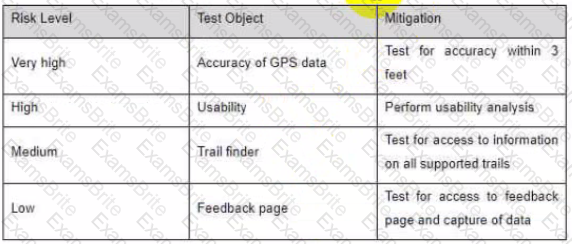
Advanced Test Management Exam v 3.0 – ISTQB
Last Update Jan 14, 2026
Total Questions : 50
We are offering FREE ATM ISTQB exam questions. All you do is to just go and sign up. Give your details, prepare ATM free exam questions and then go for complete pool of Advanced Test Management Exam v 3.0 – ISTQB test questions that will help you more.



Which of the following Is a way in which risk analysis drives testanalysis?
Which ofthe following Is the common setof information to be produced in a test estimate''
Which of the Mowing should be used to understand the context of testing within an organization?
Youare working with a development team who have a CI/CD pipeline implemented.They want to integrate your team's existing test automation into the pipeline to augment their unit tests so they will have continuous testing.They have already determined that this is technically possible with the tool youare using but withrequire some changes to the test automation framework to integrate the results reporting
What will your team need to make this happen?
Your defect opened trend is converging to the closed trend but there is still a gap. What does that gap represent?
You are managing the test team that is testing a new mobile application that provides a "step-by-step' hiking guide Your risk assessment resulted in the following table:

Your team has clone the depth and breadth testing for the GPS accuracy and usability features but when the product was given to beta testers there were some issues Despite the users reporting the app was easy to use at least one user walked off the edge of a cliffand another one ended up in a river.Your team has confirmed that the functionality is working correctly. and the GPS information is accurate.
What other area of testing should you now prioritize?
You have been looking at the actual vs expected defects in one high risk area of the software The actual is much higher than the expected value What should you do?
Which of the following is required to apply an experience-based testing approach''
You are working for an outsource testing company You have a client that will only consider candidates that are highly skilled with Salesforce. regardless of the number of years they have spent testing similar products You have looked through your skills matrix and you have no one with the right type of experience for this project.
What competence area is your team lacking?
Your team has been assigned to test a loyalty card programfor a supermarket chain.Because this is a highly competitive market significant investment has been made to determine the shortcomings of the products offered by competitors While the feature sets are mostly the same, there is a wide variance In usability and performance and the users perceptions of these quality characteristics
Given only this information what test approach would be most appropriate?
Your organization has decided to augment your testing team with an offshore team. The offshore team members are experienced testers who are experts in the domain of the system under test Your team isworried about the offshore team taking their jobs and they are resistant to the change You need to pick three of your team members to be the ambassadors for the new team
Which competences will be most important for your ambassadors to possess?
Youare working on a project where the business partof the organization works traditionally with defined requirements, but the development team follows an Agile model Neither team plans to change their approach What is the proper name for this type of project approach''